Each year, the Alan Alda Center for Communicating Science issues the Flame Challenge, challenging scientists to communicate complex subjects to 11 year olds in 300 words or less. This year, the challenge was to explain color. Although I’m not a scientist and cannot compete, I couldn’t resist.
What is color?
Color is an important part of our world, but what is color?

Picture credit: Wikimedia Commons
Color is the result of our eyes catching light in different ways.
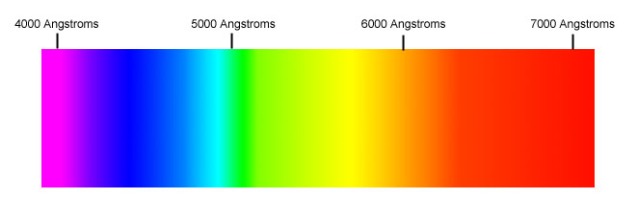
Picture credit: Sloan Digital Sky Survey
To someone that’s colorblind, these two images look the same. Color evolved so we could distinguish between shades of grey.

Picture credit: Sloan Digital Sky Survey (saved in black and white)
Other animals evolved to see slightly different portions of light.
Cats only have color receptors for green and blue, whereas humans have green, blue and red.
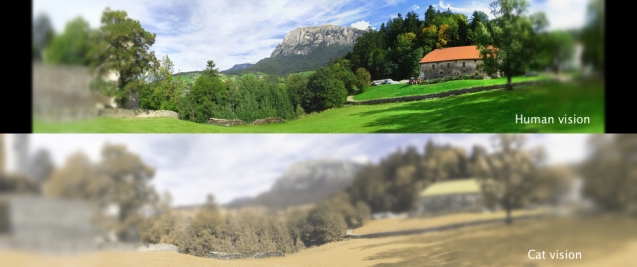
Picture credit: Nickolay Lamm
Cats may see less color, but they see better in the dark.

Picture credit: Nickolay Lamm
How can one flower be seen three different ways?
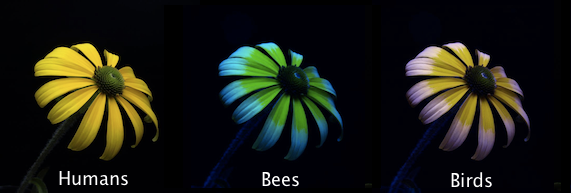
Picture credit: Nature.com
We don’t see all the light bouncing around us. We only see a thin strip of light. Shift that slightly so you have the vision of a bee, and you’ll see things that are invisible to our eyes.
If that isn’t weird enough, some animals see colors we can’t even begin to imagine.
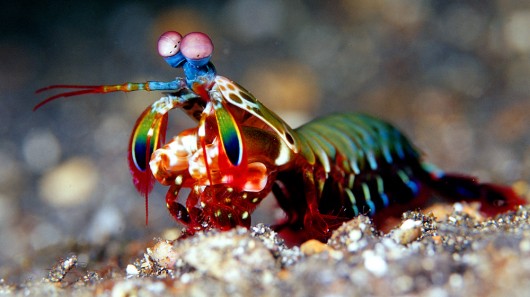
Picture credit: Mantis Shrimp, Gizmo
The mantis shrimp sees twelve primary colors! Not only do shrimp see more colors than us, shrimp see over a wider range! What do these extra colors look like? We have no idea. Just as we couldn’t explain red to someone born colorblind, we can’t picture the colors a shrimp can see.

Picture credit:Pan Studios
What would an alien see if they came to Earth?
If an alien were to visit Earth they would probably have some form of sight. Sight is so useful it evolved independently on Earth over forty different times! An alien would have to be able to see the stars before traveling to them, but their sight would have evolved on an entirely different world, so they’re probably going to see differently, just like cats and bees.

Picture credit: Arnold Schwarzenegger, Predator, Twentieth Century Fox
What is color?
A convenient way our eyes perceive light. Our eyes interpret the black-and-white world around us, adding a touch of excitement to our sight.
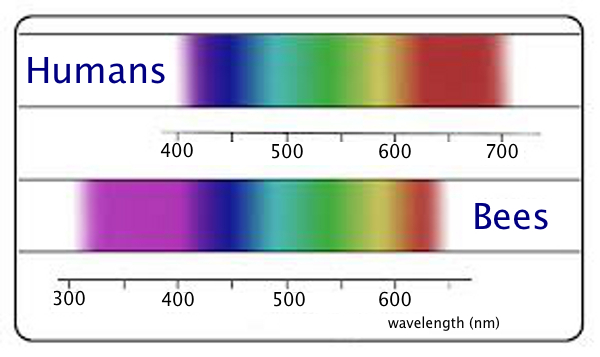
Awesome. I’ve always been curious about how other creatures see, and every time there was a show on it on Discovery (etc.) or I stumbled over an article showcasing the differences, I was fascinated.
And yes … aliens will see us differently than we see them. 😉
@Veronica Sicoe: You are right: we do. 😉
@Peter Cawdron: Wonderful essay! And any observant 11-year-old reading it will certainly be asking questions, such as: “What do the ‘UV’ and ‘IR’ on that picture mean?” or “You say that ‘Color evolved so we could distinguish between shades of grey’, so why can’t bees see the red we can and why can’t we see the violets they can?”
Now I’ve got a question for you – or any other reader: Of what earthly (or should that be aquatic?) use are all those colours to a mantis shrimp who lives in seas that filter out (or scatter) most colours except blues?
Good questions.
Selection only occurs for one of two reasons: Natural or Sexual, allowing an animal to survive and reproduce. And yet it’s not as simple as that as no species exists in isolation, there’s predator/prey, there’s cooperative strategies (think bees & flowers, etc). Evolution is an arm’s race.
Colored vision is something that probably first arose because of the naturally selective advantage it conferred (quicker, easier distinctions than just grey vision would allow an animal to avoid a predator, or conversely to allow a predator to find it’s prey quicker, etc), and it could have been extended due to sexually selective or the cooperative advantages that came with it (peahens choosing peacocks, beautiful coloration of fish is an appeal to sexual selection, etc). Color vision evolved hundreds of millions of years before Homo sapiens arose, we simply took advantage of it like everyone else.
Cats and interesting. We think of their vision as restricted, but they’ve traded color for night vision, etc. And that summarises evolution quite well, it’s a trade-off.
Why does the Mantis shrimp see soooo much? You’d have to check the scientific literature, but given their exotic coloration, I’d expect sexual selection played a big part. Also, the sensitivity to polarised light would be useful to a undersea creature in avoiding predators (changes in polarisation can be caused by light reflecting off fish scales and would tip off the shrimp to an approaching predator, etc)
Oh, the challenge with this post was (a) keeping it focused on a specific audience and (b) staying under the word count limit.
Cheers,
Peter